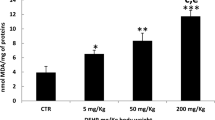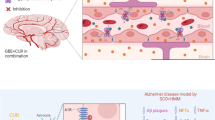Abstract
We studied the intensity of lipid peroxidation (LP) and the amount of a marker of astrocytes (glial fibrillary acidic protein, GFAP) in tissues of the rat brain under conditions of long-lasting consumption (12 weeks) of ethyl alcohol, as well as the protective effects of peroral administration of hydrated forms of fullerene ?60 (?60HyFn, FWS, fullerene water solutions). Consumption of ethanol resulted in a rise in the amount of molecular markers of oxidative stress (thiobarbiturate-active compounds) in the cerebral tissues. The level of the filamentous GFAP form in the hippocampus and cerebral cortex of alcoholized animals decreased significantly, which can be a result of death of the population of GFAP-imunnoreactive astrocytes in the brain. In the brain of rats after systematic consumption of both ethanol and an aqueous solution of hydrated fullerenes ?60, the amounts of products of lipid peroxidation and of the astroglial marker did not differ significantly from the respective indices in the control animals. Our data demonstrate the efficiency of hydrated fullerenes as pathogenetic therapeutic remedies for elimination of the negative effects of ethyl alcohol on the CNS.
Similar content being viewed by others
References
Yu. V. Burov and N. N. Vedernikova, Neurochemistry and Pharmacology of Alcoholism [in Russian], Meditsina, Moscow (1985).
A. Augustyniak, K. Michalak, and E. Skrzydlewska, “The action of oxidative stress induced by ethanol on the central nervous system (CNS),” Postepy Hig. Med. Dosw., 59, 464–471 (2005).
L. Meda, P. Baron, and G. Scarlato, “Glial activation in Alzheimer’s disease: the role of A-beta and its associated proteins,” Neurobiol. Aging, 22, No. 6, 885–893 (2001).
L. F. Eng, R. S. Ghirnikar, and Y. L. Lee, “Glial fibrillary acidic protein: GFAP-Thirty-One years (1969–2000),” Neurochem. Res., 25, Nos. 9/10, 1439–1451 (2000).
P. Wentzel, U. Rydberg, and U. J. Eriksson, “Antioxidative treatment diminishes ethanol-induced congenital malformations in the rat,” Alcohol. Clin. Exp. Res., 30, No. 10, 1752–1760 (2006).
H. W. Kroto, S. Heath, S. C. O’Brien, et al., “C60: Buckminsterfullerene,” Nature, 318, 162–162 (1985).
V. I. Trefilov, D. V. Shchur, B. P. Tarasov, et al., Fullerenes as the Basis for Futuristic Materials [in Russian], Institute of Polymer Materials of the Natl. Acad. Sci. of Ukraine and Institute of Polymer Chemical Substances of the Russ. Acad. Sci., Kyiv (2001).
P. J. Krustic, E. Wasserman, P. N. Keizer, et al., “Radical reactions of C60,” Science, 254, 1183–1185 (1991).
L. B. Piotrovskii, “Fullerenes in biology and medicine,” in: Fundamental Directions of Molecular Medicine [in Russian], Rostok, Saint Petersburg (2005), pp. 197–268.
G. V. Andrievsky, M. V. Kosevich, O. M. Vovk, et al., “On the production of an aqueous colloidal solution of fullerenes,” J. Chem. Soc. Chem. Commun., 12, 1281–1282 (1995).
G. V. Andrievsky, V. K. Klochkov, A. B. Bordyuh, and G. I. Dovbeshko, “Comparative analysis of two aqueous-colloidal solutions of C60 fullerene with help of FTIR re?ectance and UV-Vis spectroscopy,” Chem. Phys. Lett., 364, 8–17 (2002).
I. Y. Podolski, E. V. Kondratjeva, S. S. Gurin, et al., “Fullerene C60 ?omplexed with poly(N-vinylpyrrolidone) (C60/PVP) prevents the disturbance of long-term memory consolidation induced by cycloheximide,” Fullerenes, Nanotubes, Carbon Nanostruct., 12, Nos. 1/2, 421–424 (2005).
I. Y. Podolski, Z. A. Podlubnaya, E. A. Kosenko, et al., “Effects of hydrated forms of C60 fullerene on amyloid β-peptide ?brillization in vitro and performance of the cognitive task,” J. Nanosci. Nanotech., 7, Nos. 4/5, 1479–1485 (2007).
G. V. Andrievsky, “Surprising positive biological effects of hydrated C60 fullerene as the basis for creation of a wide spectrum of products with unique bioactivity,” in: Fullerenes and Atomic Clusters (St. Petersburg, June 27–July 1), Saint Petersburg (2005), p. 235.
V. S. Nedzvetsky, M. Tuzcu, A. Yasar, et al., “Effects of vitamin E against aluminum neurotoxicity in rats,” Biochemistry, 71, No. 3, 239–244 (2006).
M. M. Bradford, “A rapid and sensitive method for the quantitation of microgram quantities of protein utilizing the principle of protein-dye binding,” Anal. Biochem., 72, 248–254 (1976).
U. K. Laemmli, “Cleavage of structural proteins during the assembly of the head of bacteriophage T4,” Nature, 227, 680–685 (1970).
H. Towbin, “Immunoblotting-an update,” Biochem. Soc. Trans., 16, No. 2, 131 (1988).
V. I. Lushchak, T. V. Bagnyukova, and O. V. Lushchak, “Indices of oxidative stress. Thiobarbiturate-active products and carbonyl groups of proteins,” Ukr. Biokhim. Zh., 76, No. 3, 136–141 (2004).
S. N. Lapach, A. V. Chubenko, and P. N. Babich, Statistical Techniques in Medico-Biological Studies with the Use of Excel [in Russian], Morion, Kyiv (2000).
S. Gemma, S. Vichi, and E. Testai, “Individual susceptibility and alcohol effects: biochemical and genetic aspects,” Ann. Ist. Super Sanita, 42, No. 1, 8–16 (2006).
A. I. Cederbaum, “CYP2E1-biochemical and toxicological aspects and role in alcohol-induced liver injury,” Mount Sinai J. Med., 73, No. 4, 657–672 (2006).
G. Baydas, A. Yasar, and M. Tuzcu, “Comparison of the impact of melatonin on chronic ethanol-induced learning and memory impairment between young and aged rats,” J. Pineal Res., 39, No. 4, 346–352 (2005).
L. L. Dugan, E. G. Lovett, K. L. Quick, et al., “Fullerene-based antioxidants and neurodegenerative disorders,” Parkinsonism Relat. Disord., 7, 243–246 (2001).
T. H. Ueng, J. J. Kang, H. W. Wang, et al., “Suppression of microsomal cytochrome P450-dependent monooxygenases and mitochondrial oxidative phosphorylation by fullerenol, a polyhydroxylated fullerene C60,” Toxicol. Lett., 93, 29–37 (1997).
L. L. Dugan, D. M. Turetsky, C. Du, et al., “Carboxyfullerenes as neuroprotective agents,” Proc. Natl. Acad. Sci. USA, 94, 9434–9439 (1997).
D. J. Wolff, C. M. Barbieri, C. F. Richardson, and D. I. Schuster, “Trisamine C60-fullerene adducts inhibit neuronal nitric oxide synthase by acting as highly potent calmodulin antagonist,” Arch. Biochem. Biophys., 399, No. 2, 130–141 (2002).
N. Gharbi, M. Pressac, M. Hadchouel, et al., “[60] Fullerene is an in vivo powerful antioxidant with no acute or sub-acute toxicity,” NanoLett., 5, No. 12, 2578–2585 (2005).
G. V. Andrievsky, V. K. Klochkov, and L. I. Derevyanchenko, “Is C60 fullerene molecule toxic?” Fullerenes, Nanotubes, Carbon Nanostruct., 13, No. 4, 363–376 (2005).
J. J. Miguel-Hidalgo, “Lower packing density of glial fibrillary acidic protein-immunoreactive astrocytes in the prelimbic cortex of alcohol-naive and alcohol-drinking alcohol-preferring rats as compared with alcohol nonpreferring and Wistar rats,” Alcohol. Clin. Exp. Res., 29, 766–772 (2005).
P. L. Hoffman, M. Miles, H. J. Edenberg, et al., “Gene expression in brain: a window on ethanol dependence, neuroadaptation, and preference,” Alcohol. Clin. Exp. Res., 27, 155–168 (2003).
H. M. Huang, H. C. Ou, S. J. Hsieh, and L. Y. Chiang, “Blockade of amyloid beta peptide-induced cytosolic free calcium by fullerenol-1, carboxylate C60_in PC12_cells,” Life Sci., 66, No. 16, 1525–1533 (2000).
K. Kaneko, A. Nakamura, K. Yoshida, et al., “Glial brillary acidic proteinis greatly modi?ed by oxidative stress in aceruloplasminemia brain,” Free Rad. Res., 36, No. 3, 303–306 (2002).
G. Baidas, E. Donder, M. Kiliboz, et al., “Neurodefense by α-lipoic acid in streptozotocin-induced diabetes,” Biokhimia, 69, No. 9, 1233–1238 (2004).
Author information
Authors and Affiliations
Corresponding authors
Additional information
Neirofiziologiya/Neurophysiology, Vol. 39, No. 2, pp. 119–125, March–April, 2007.
Rights and permissions
About this article
Cite this article
Tikhomirov, A.A., Nedzvetskii, V.S., Lipka, M.V. et al. Chronic alcoholization-induced damage to astroglia and intensification of lipid peroxidation in the rat brain: Protector effect of hydrated form of fullerene C60 . Neurophysiology 39, 105–111 (2007). https://doi.org/10.1007/s11062-007-0015-8
Received:
Issue Date:
DOI: https://doi.org/10.1007/s11062-007-0015-8




